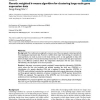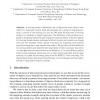2277 search results - page 29 / 456 » Clustering by pattern similarity in large data sets |
BMCBI
2008
13 years 7 months ago
2008
Background: The traditional (unweighted) k-means is one of the most popular clustering methods for analyzing gene expression data. However, it suffers three major shortcomings. It...
EDBT
2004
ACM
14 years 7 months ago
2004
ACM
Structured and semi-structured object representations are getting more and more important for modern database applications. Examples for such data are hierarchical structures inclu...
PR
2008
13 years 7 months ago
2008
The "bag-of-frames" approach (BOF) to audio pattern recognition models signals as the long-term statistical distribution of their local spectral features, a prototypical...
ICML
2007
IEEE
14 years 8 months ago
2007
IEEE
We consider the problem of learning a similarity function from a set of positive equivalence constraints, i.e. 'similar' point pairs. We define the similarity in informa...
SSD
2005
Springer
14 years 1 months ago
2005
Springer
A moving cluster is defined by a set of objects that move close to each other for a long time interval. Real-life examples are a group of migrating animals, a convoy of cars movin...



